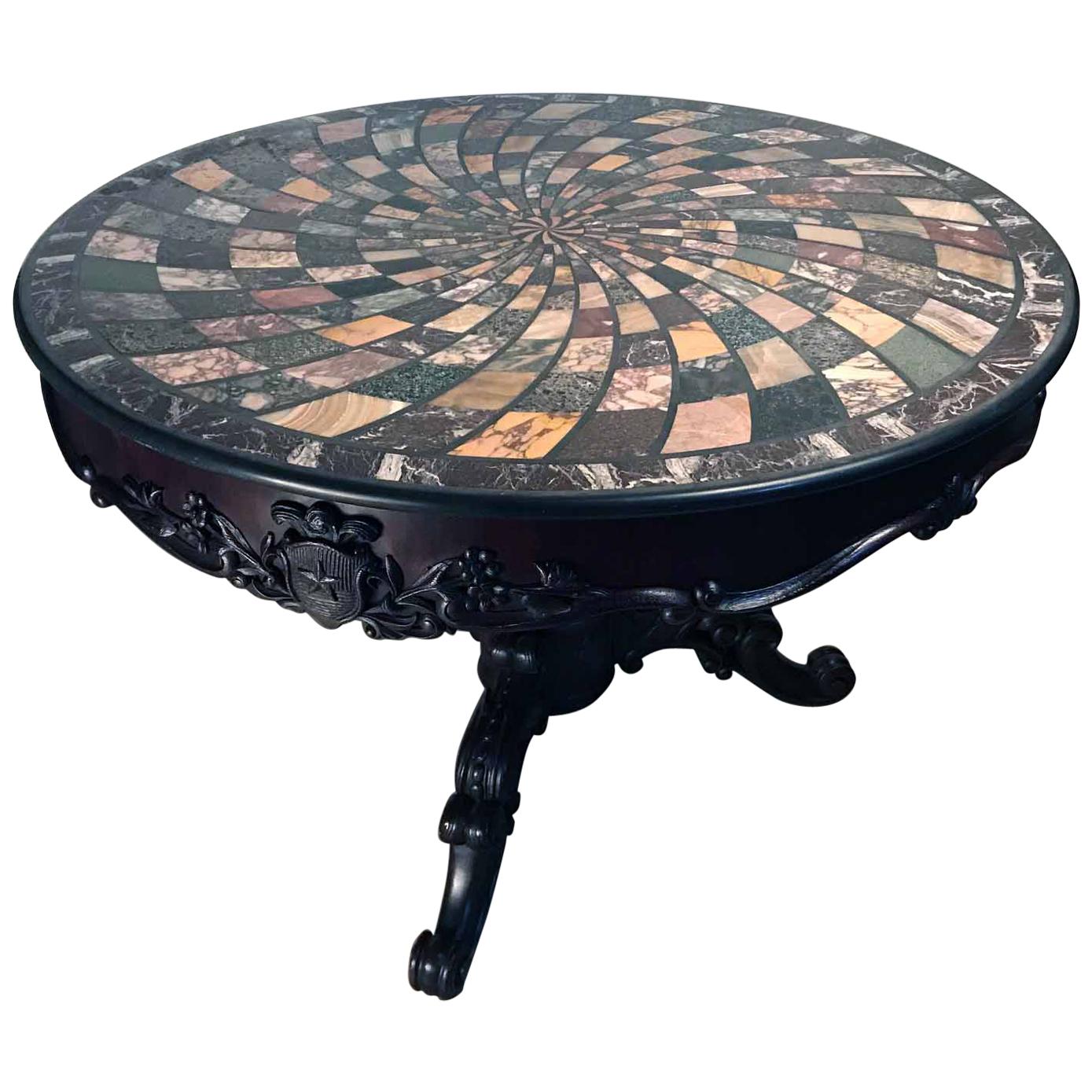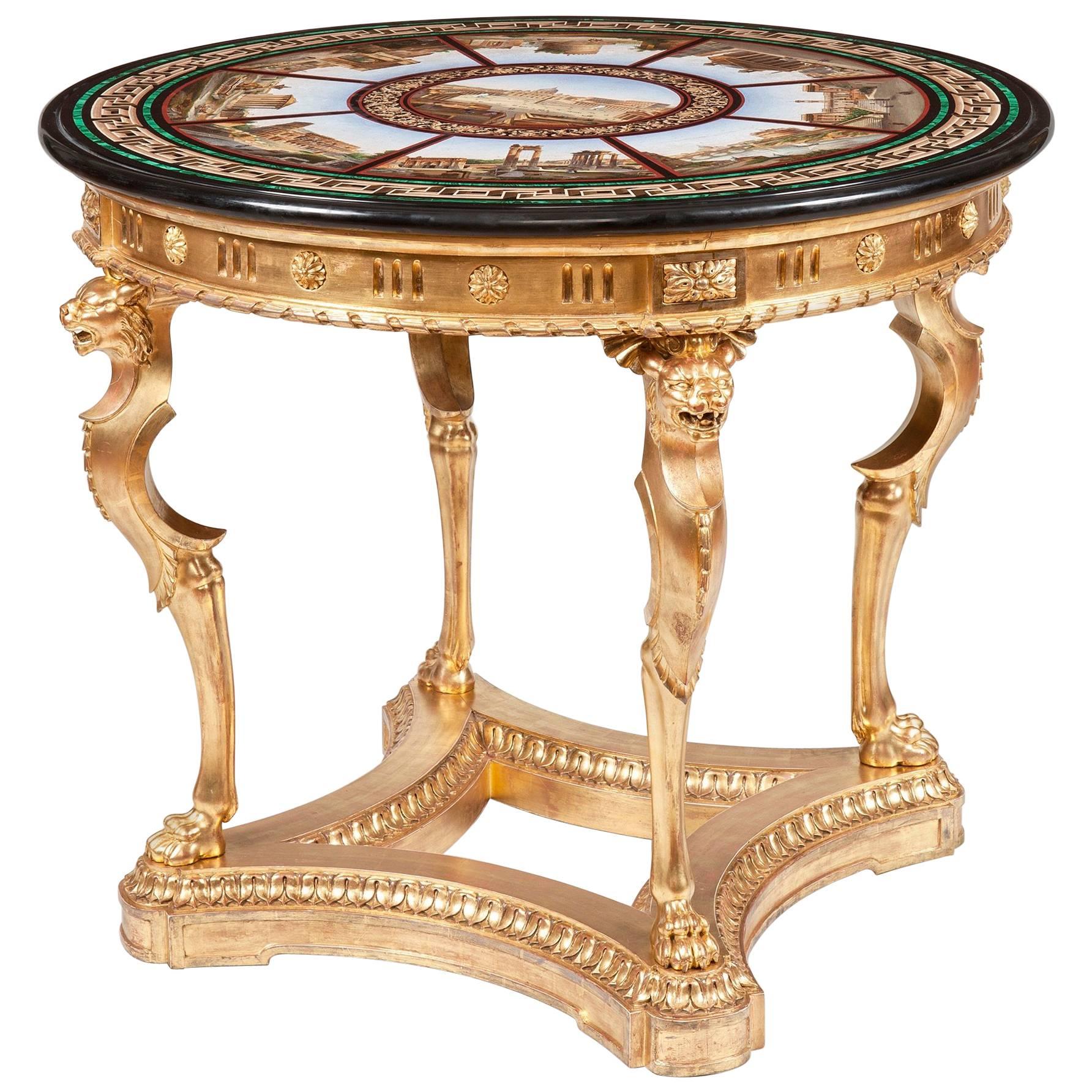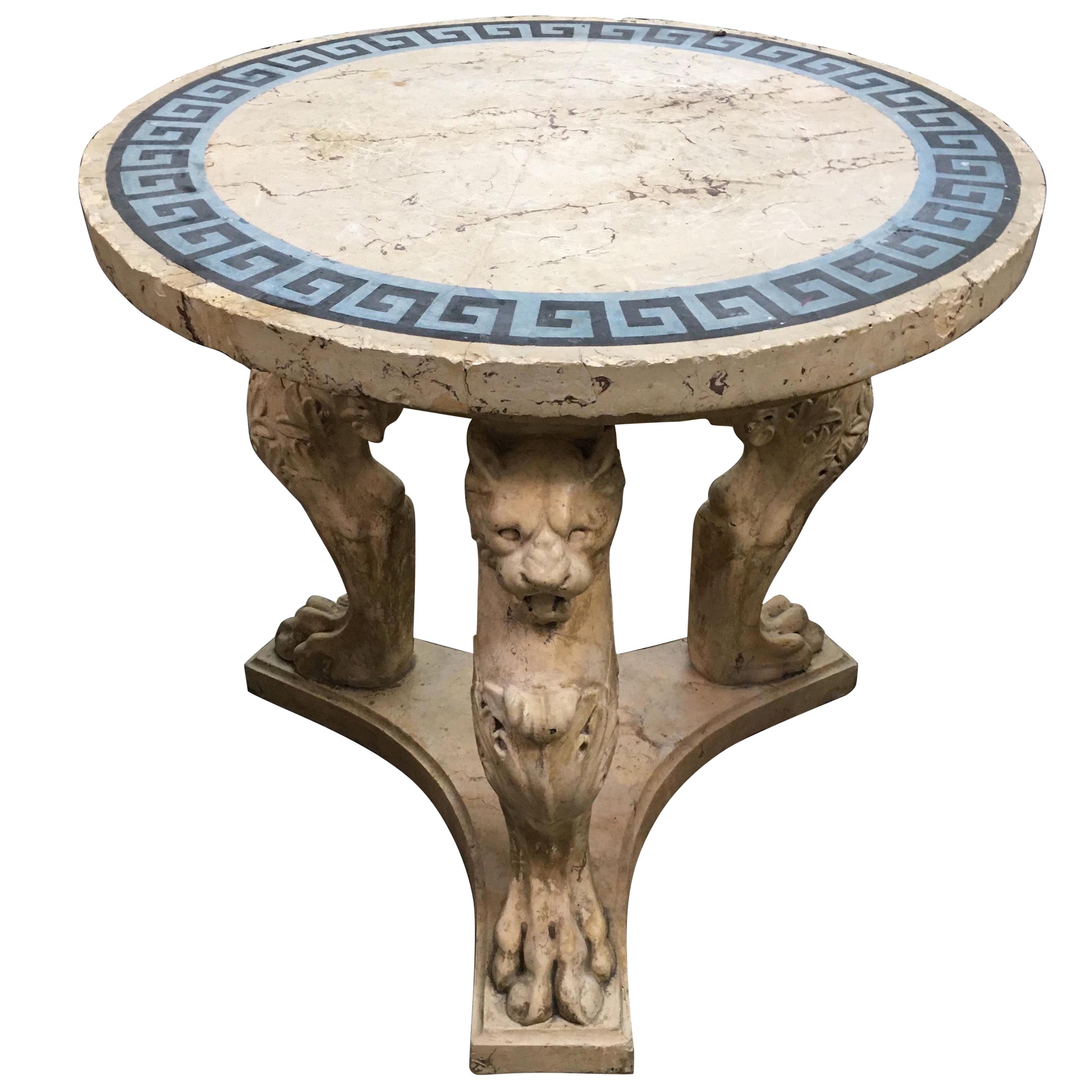Items Similar to 19th Century 'Grand Tour' Marble Top Table with Base attributed to Trotter
Want more images or videos?
Request additional images or videos from the seller
1 of 9
19th Century 'Grand Tour' Marble Top Table with Base attributed to Trotter
About the Item
An Impressive 'Grand Tour' Specimen Marble Top Centre Table
The base attributed to William Trotter of Edinburgh
Constructed in a finely patinated mahogany, with a Florentine Pietra Dura radially inlaid platform. Rising from an incurved tripartite platform base dressed with a reeded moulding, having carved lion's paw feet, mounted on castors, supporting a circular turned, beaded, and fluted centre column, carved with stiff leaf foliates: the marble circular top decorated with a central circular boss of lapis lazuli, issuing radially laid segments of specimen marbles, including Malachite, Porphyry, Breccia and Agates, inter alia, enclosed within an outer guard band of Antico Verde.
The base; Scottish, circa 1825
The top; Italian, circa 1815
A similar lapis-centred top, together with some thirty-two identified marbles, is displayed in London's Natural History Museum.
Provenance:
From a titled Irish family
William Trotter (1772 - 1833)
The most prominent and successful Cabinet Maker in Scotland, his extensive premises were described in Thomas Dibdin's 'Tour in the North Countries of England and Scotland', quoting, in part 'The locality of this great...warehouse is rather singular. It is on the ground floor, lighted by a skylight, of great length and vistas, filled with Mahogany and Rosewood objects of temptation of all styles, including the modern form'.
- Attributed to:William Trotter (Cabinetmaker)
- Dimensions:Height: 30.5 in (77.47 cm)Diameter: 38 in (96.52 cm)
- Style:Grand Tour (Of the Period)
- Materials and Techniques:
- Place of Origin:
- Period:
- Date of Manufacture:circa 1815-1825
- Condition:Repaired: Each item has undergone careful inspection and restoration by a conservation specialist in order to guarantee the original quality and integrity of the object. Wear consistent with age and use.
- Seller Location:London, GB
- Reference Number:
About the Seller
5.0
Recognized Seller
These prestigious sellers are industry leaders and represent the highest echelon for item quality and design.
Gold Seller
These expertly vetted sellers are highly rated and consistently exceed customer expectations.
Established in 1964
1stDibs seller since 2012
42 sales on 1stDibs
Typical response time: 3 hours
Associations
The British Antique Dealers' AssociationLAPADA - The Association of Arts & Antiques Dealers
- ShippingRetrieving quote...Ships From: London, United Kingdom
- Return PolicyA return for this item may be initiated within 3 days of delivery.
More From This SellerView All
- Rare 19th Century Grand Tour Marble Top Table on Giltwood BaseLocated in London, GBA superb Specimen marble centre table The Top attributed to Alfonso Cavamelli of Rome Inspired by the Roman mosaics discovered at the ...Category
Antique 19th Century Italian Grand Tour Center Tables
MaterialsMalachite, Marble, Porphyry
- 19th Century Italian Micro-Mosaic Grand Tour Table Attributed to RoccheggianiBy Cesare RoccheggianiLocated in London, GBA rare grand tour table Possibly by Cesare Roccheggiani The circular platform of marmore nero, inset with fine micromosaic panels consisting of thousands of coloured glass tesserae; a central roundel depicting The Vatican from St Peter's Square within a malachite border, surrounded by a border including four cartouches in polychrome reserves of Roman views including the Coliseum, the Roman Forum, with the remnants of the Temple of Vespasian; the Temple of Vesta, and the Pantheon, all interspersed and linked by voluminous bouquets of fruit and flowers representing the 4 seasons; the outer stylised border inlaid with deep blue tesserae evocative of exotic Lapis Lazuli. Supported on a finely carved Italian giltwood base, its design incorporating baskets of fruit and floral garlands echoing the 4 seasons theme of the table. Italian, Circa 1875 Other table tops inspired by this design, although not as finely executed, can be found in several Russian collections (which house the greatest micromosaics) including Vorontsov Palace, Muranovo House, as well as the imperial State Hermitage Museum. A tabletop with profuse floral micromosaic work was commissioned by the Belgian Royal family (sold Sotheby's, 2003). The floral garlands, the magnificent quality of the inlay and the use of distinct curved tesserae support the present attribution to Cesare Roccheggiani. According to Jeanette Hanisee Gabriel, the world expert on micro mosaics, curved tesserae pieces were used in foliage, grass and animal fur by only the very best mosaicists such as Roccheggiani. Evidence of curved pieces, for instance, is observed in the foreground of the Temple of Vesta cartouche, to name but one observation of the master's hand. The scion of a dynasty of mosaicists, Roccheggiani was perhaps the most successful mosaicist in the last quarter of the nineteenth century. He is doubtless related to Lorenzo Roccheggiani, a late eighteenth-century master mosaicist at the Vatican, whose work included the altarpiece, Crucifixion of St. Peter after Guido Reni. Nicolo Roccheggiani, possibly Lorenzo's son, was also a principle artist at the Vatican, involved in executing the famous tabletop Achilles Shield...Category
Antique 19th Century Italian Grand Tour Center Tables
MaterialsMalachite, Marble, Belgian Black Marble
- 19th Century Grand Tour' Giltwood and Micromosaic Centre Table with Roman ScenesLocated in London, GBA Grand Tour Centre Table The Top Attributed to Cesare Roccheggiani The carved gilt wood base in the manner of George Smith having four monopedia supports, each depicting leopards heads atop, with paw feet below, and conjoined by an incurved stretcher base having carved stiff leaf decoration, and raised on castors; the circular platform of marmoro nero, with a stylised Greek Key border within double Malachite reserves; the central micromosaic roundel depicts The Vatican from St Peter's Square, surrounded by eight separate roundels of The Pantheon of the Gods; the smallest of Rome's seven hills, the Capitoline; The Mauseoleum of Hadrian on the Tiber; The Roman Forum, with the remnants of the Temple of Vespasian; The Colosseum; the Temple of Vesta; The Arch of Titus, and the Tomb of Cecilia Metella. English / Italian, Circa 1875 The attribution to Cesare Roccheggiani is supported by Jeanette Hanisee Gabriel, former curator of the Gilbert Collection and Honorary Curator for the Gilbert Collection at the Victoria & Albert Museum. Provenance: From a Noble family, the 6th Earl of Macclesfield (1811-1896) then by descent. The base is similar in design to designs published by George Smith's A Collection of Designs for Household Furniture and Interior Decoration, 1808. The taste for monopedia supports was of fashion, in the Regency period and models of such were displayed in the 1851 Great Exhibition. The Macclesfield coat of arms depicts a shield with a central chevron and three leopard's faces. Views of Roman monuments was the most popular theme used by mosaicists in Rome in the beginning of the 19th century, supplying the flow of wealthy Grand tourists from Northern Europe. From small gold boxes...Category
Antique 19th Century Italian Grand Tour Center Tables
MaterialsMalachite
- 19th Century Coromandel and Inlaid Table Attributed to Jackson & GrahamBy Jackson & GrahamLocated in London, GBA magnificent library table Attributed to Jackson & Graham Of free standing rectangular form, constructed in coromandel, with inlays in thuya, ebony, boxwood, and honeysuckle; the fluted legs rising from square brass castor-shod feet; the frieze housing two lockable drawers fitted with rare ‘tamper proof’ Chubb locks and having quadrant moulded cedar lined interiors; the platform having a central panel of beautifully chosen matched coromandel veneers, with an outer guard border of a running pattern of stylised anthemions; the ebony edges having a thumb nail moulding, circa 1865 The firm of Jackson & Graham established in 1836 by Thomas Jackson and Peter Graham at 37 Oxford Street London, and for the next fifty years produced predominately high quality furniture and represented Britain at many of the international exhibitions. Their clients included Queen Victoria, Napoleon III, the Grand Khedive of Cairo and the royal palace in Siam. They were particularly noted for their fine marquetry work, the use of Wedgwood plaques, rare woods, and fine casting of bronze mounts. They engaged the leading designers of the period, inter alia, Owen Jones, Bruce Talbert, Alfred Lorimer and Eugene Prignot. In the mid-1850s the workforce was recorded as 250, and by 1875, the company was employing 600 workers. They were feted exhibitors at many of the Great Exhibitions of the 19th century, and frequent prize winners. At the Paris International Exhibition of 1878, the furniture jury noted of them ‘ the workmanship is so perfect that even with the aid of a magnifying glass scarcely the slightest imperfection is to be found’. In 1885 the company was absorbed by Collinson and Lock, who continued their standard of excellence. Charles Chubb was apprenticed as a blacksmith before starting business as a ships’ ironmonger in Winchester. Jeremiah soon joined the business, and by 1818 the brothers had branched out into lockmaking, founding the famous Chubb Company. The business really got started when Jeremiah Chubb patented his new ‘detector lock’ in 1818. The lock was constructed so that if someone tried to pick it or open it with the wrong key it became inoperable. To make the lock work again the owner had to use a special key supplied with the lock. The aim of the detector lock was to prevent burglaries, and to warn the owner that someone had tried to break into their property. The lock soon became popular, and sales of the Chubbs’ products increased even more when they won a government competition to design a lock that could only be opened using its own key. After the invention of the detector lock, the Chubbs decided to move to Wolverhampton, which already had an established lock making industry. By 1838 they were making 28,000 locks a year at their Wolverhampton factory. Another product was added to the Chubb range in 1835 when a patent was taken out for a burglar resistant safe, and in 1837 the Chubb safe...Category
Antique 19th Century English Tables
MaterialsBrass
- English 19th Century Walnut Occasional Table with Watercolor TopLocated in London, GBConstructed in walnut; rising from a quadripartite base, the cabriole and hipped legs with scrolled toes, and a central carved oblate pendant finial; the tapering and turned column, ...Category
Antique 19th Century British Early Victorian Center Tables
MaterialsWalnut, Glass, Paint
- 19th Century Micromosaic Table Top with Views of Rome from the Grand TourLocated in London, GBA grand tour circular table top Possibly by Domenico Moglia The circular platform of marmore nero, inset with fine micromosaic panels consisting of hundreds of coloured glass tesserae; a central flower bouquet sit within a malachite border surrounded by a border including four cartouches in conforming malachite reserves representing Roman views including the Arch of Titus, the Temple of Vesta, the Capitoline Hill, and the Tomb of Cecilia Metella, connected by floral garlands. Italy, circa 1855 Domenico Moglia (1780 - 1862) Brothers, Luigi and Domenico Moglia, are celebrated as two of the few great mosaicists of the 19th century. Both are recorded as exhibiting at the 1851 Great Exhibition, London. Domenico's work included micromosaics plaques depicting views of 'the roman forum', 'the colosseum', and the 'temples of Paestum.' The Lombardi Museum contains a collection of architectural...Category
Antique 19th Century Italian Grand Tour Tables
MaterialsMalachite, Marble
You May Also Like
- Grand Tour Mid 19th Century Neoclassical Marble GueridonLocated in Essex, MAMid 19th century carved marble gueridon in the neoclassical taste. All marble. Carved throughout. Top carved in full classical style. Monopod lion legs , tripartate base. Wonderful t...Category
Antique Mid-19th Century Italian Grand Tour Center Tables
MaterialsSiena Marble, Statuary Marble
- Specimen Marble-Topped Table, Grand TourLocated in Montreal, QCThis is a rare and superb survival. Not merely do we have this intricately inlaid parquetry top, resplendent with various coloured marbles, but we even have the original walnut cente...Category
Antique Mid-19th Century Italian Grand Tour Center Tables
MaterialsMarble
- Incredible Rare 19th Century Italian Grand Tour Scagliola Center TableLocated in Charleston, SCIncredible rare 19th century Italian Grand Tour scagliola center table. The classical inspired table features the Greek key decorated lintel top supported by a tryptich of monop...Category
Antique 19th Century Italian Grand Tour Center Tables
MaterialsScagliola
- French 19th Century Mahogany, Ormolu and Marble Table, Attributed to DassonBy Henry DassonLocated in West Palm Beach, FLA stunning and extremely high quality French 19th century Louis XVI style mahogany, ormolu and vert campan marble side/center table, after a model by Adam Weisweiler and attributed to Henry Dasson. The table is raised by fine topie shaped feet with elegant circular tapered supports. Each leg displays a unique square tapered shape with a carved recessed design and elegant foliate ormolu movements which encase the leg. Each are connected by a fine mahogany stretcher with elegant beaded ormolu bands and a lovely central floral reserve. Above are impressive richly chased caryatids with lovely flowing drape and tied hair below intricately detailed floral baskets. The straight frieze displays a recessed panel framed in a fine mottled ormolu band. The frieze is centered by a charming and richly chased pierced ormolu mount with a central floral bouquet and crossed staff...Category
Antique 19th Century French Louis XVI Center Tables
MaterialsMarble, Ormolu
- EARLY 19th CENTURY ROUND WALNUT TABLE WITH MARBLE TOPLocated in Firenze, FIBeautiful walnut coffee table with a refined central frame in ebonized and gilded wood. The triangular-shaped base is supported by turned and ebonized pine cones, while the band has ...Category
Antique Early 19th Century Italian Empire Center Tables
MaterialsMarble, Carrara Marble
- 19th Century English Marble-Topped Pedestal TableLocated in Locust Valley, NY19th century English marble-topped wood pedestal table, claw foot base with a purbeck marble top.Category
Antique 19th Century English Pedestals
MaterialsMarble
Recently Viewed
View AllMore Ways To Browse
William Trotter
Antique French Boulle Centre Table Circa 1860
Antique Chinese Mother Of Pearl Inlay Table
Antique Chinese Pearl Inlay Tables Inlay Tables
Vintage Center Table Book Shaped
Tomlin Antiques
Antique Loo Tables
Francesco Molon Tables
Epicure V Center Table
Round Center Table Pearl
Ceylonese Table
Onda Contemporary Coffee Table
Victorian Marble Turtle Top Table
Antonio Devoto
Crome Center Table
Ninja Throwing
Sheraton Drum Table
George Iii Drum Table





